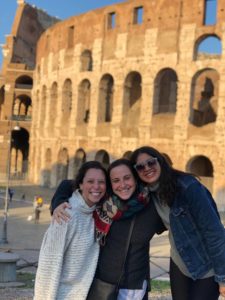Yael Kornfeld and Gaby Natelson take part in the “Kerem” Cohort of National Ramah and recently went to Israel for Mishlachat Interviews with the cohort, and then to Italy. Kerem is the national network of young professionals working year-round for Ramah camps and the National Ramah office. This program is generously funded by the Jim Joseph Foundation, supporting leadership development for Jewish education leaders

Visiting an international destination is always an exciting experience, but traveling internationally to a country with 18 other Ramah professionals to learn about Jewish life and practice, is truly something special. This past February, Gaby and I were fortunate enough to go to Rome, Italy with Kerem – National Ramah Commission’s young-professionals cohort.
Through this 5-day visit, we had the opportunity to learn about the Jewish community and how it operates in Rome. My experience abroad continued to prove to me Judaism’s impeccable ability to adapt to its surroundings, grow with a community, and remain relevant…even after 2000+ years in an area. This community reminds me as a camp professional to be unafraid to think outside of the box to continue to make Judaism relevant and tangible to our ever-evolving community.
With around 16,000 people, the Jewish community in Rome is thriving. However, this community does not resemble Jewry as we know it in America, rather there are many characteristics that make it individualized and unique. In general, a recurring theme of centralization runs throughout their structure and customs. For starters, rather than paying dues to an individual synagogue, practicing Jews in Rome pay a fee to Judaism as an organization. The organization is run by a council, and all money is allocated to synagogues, youth movements, JCCs, Rabbis’ salaries, etc. as seen fit. Members pay an extra fee for each life event – baby naming, brit milah, bar/bat mitzvah, wedding, funeral, etc. The Jewish community in Rome also does not believe in dividing by sector. Rather, they all identify with the same sect of Judaism and combine customs from each to create their own conglomeration– though every shacharit service will have a mechitzah, households may not keep kosher, and driving to synagogue on Shabbat may be the norm. Our tour guide explained that Roman Judaism is ‘orthodox in prayer, reform in lifestyle, and conservative in practice.’ They’ve created a way to incorporate all elements into one body, so everyone feels comfortable and part of a larger community. Lastly, during our visit to the local JCC, we were reminded of this pluralistic mindset as we sat with two year-long shlichim who were brought to Rome to work with the same organization that umbrella the most Reform youth movement and the most Orthodox youth movement. Though the two movements do separate programming, they are connected through the JCC, and the children are exposed to both viewpoints.
Sitting in front of the Colosseum, staring at its grandeur and presence, we soon made the connection between the building of this massive arena to the Beit HaMikdash. The year 70 A.D. resembling the destruction of the Beit HaMikdash and the building of the Colosseum. A small plaque in the exhibit commemorates the spoils stolen from the Beit HaMikdash to build and afford the Colosseum. Destruction and difficult times continued for the Jews in Rome. With the rise of the Catholic church, Jews were ostracized to a ghetto where the goal was conversion. Times did not improve until after WWII.
When examining a history where the Jewish people could have been eliminated and Judaism could have easily been replaced with Catholicism and comparing it to the Jewish community that exists today, Rome serves as a reminder and an example to camp that Judaism has the ability to remain strong and relevant in all places – if the religion and its people are willing to grow and adapt to its surroundings. The theme of centralization within Roman Jewry is no surprise – home of the Vatican, the most powerful church and centralized system in Catholicism, Roman Jewry mimicked what they saw around them and centralized their own religion to remain a contender and create a united front. The Roman Jewish community reminds us as camp professionals that Judaism does not need to look the same around the world or remain the same for 2000+ years within the same area. Rather, the goal is to find a way to infuse it authentically and make it relevant. The Roman Jewish community is still thriving, with its centralized structure, conglomeration of customs, and pluralistic mindset.
